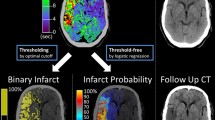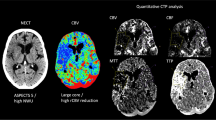Abstract
Cerebral infarct due to embolic stroke without recanalization was examined by cerebral blood flow (CBF) SPECT in the early acute stage, and the possibility of predicting the size it will reach in the later stages was evaluated. Twenty patients (67 ± 13 years) were examined by CBF SPECT with99mTc-ECD 4.5 ± 3.1 hours after the onset of cardiogenic cerebral embolism. The ratio of the anteroposterior length of the cerebral hemisphere to that of the severe ischemic region, which was defined as an area of clear-cut severe reduction in CBF as observed by SPECT, was calculated. One week after the onset, the cerebral infarct was measured in the same manner by CT, and the relationship between the two measurements was evaluated. The CBF in the region of severe ischemia and the surrounding region was determined by the Patlak plot method, and the affected/non-affected (A/ NA) ratio was calculated. In severe ischemic regions the CBF ranged from 1.7 ml/100 g/min to 20 ml/100 g/min (mean, 11 ± 5 ml/100 g/min), whereas the A/NA ratio ranged from 4% to 45% (mean, 26±11%). On the other hand, the CBF in the surrounding regions ranged from 20 ml/100 g/min to 52 ml/100 g/min (mean, 34 ± 8 ml/100 g/min) whereas the A/NA ratio ranged from 52% to 104% (mean, 77 −11 %). The coefficient of correlation between the infarct size predicted by SPECT and that measured by CT was r = 0.986, and the correlation equation was Y = 1.047X–2.969. CBF SPECT performed in the early acute stage can be used to predict the size of cerebral infarct.
Similar content being viewed by others
References
Hacke W, Kaste M, Fieschi C, Toni D, Lesaffre E, von Kummer R, et al. Intravenous thrombolysis with recombinant tissue plasminogen activator for acute hemispheric stroke: the European Cooperative Acute Stroke Study (ECASS).JAMA 274: 1017–1025, 1995.
The National Institute of Neurological Disorders and Stroke rt-PA Stroke Study Group. Tissue plasminogen activator for acute ischemic stroke.N Engl J Med 333: 1581–1587, 1995.
Donnan GA, Davis SM, Chambers BR, Gates PC, Hankey GJ, McNeil JJ, et al. Streptokinase for acute ischemic stroke with relationship to time of administration.JAMA 276: 961–966, 1996.
Wall SD, Brant-Zawadzki M, Jeffrey RB, Barnes B. High frequency CT findings within 24 hours after cerebral infarction.AJR 138: 307–311, 1982.
Truwit CL, Barkovich AJ, Gean-Marton A, Hibri N, Norman D. Loss of the insular ribbon: another early CT sign of acute middle cerebral artery infarction.Radiology 176: 801–806, 1990.
Horowitz SH, Zito JL, Donnarumma R, Patel M, Alvir J. Computed tomographic-angiographic findings within the first five hours of cerebral infarction.Stroke 22: 1245–1253, 1991.
Warach S, Gaa J, Siewert B, Wielopolski P, Edelman RR. Acute human stroke studied by whole brain echo planar diffusion-weighted magnetic resonance imaging.Ann Neurol 37: 231–241, 1995.
Sorensen AG, Buonanno FS, Gonzalez RG, Schwamm LH, Lev MH, Huang-Hellinger FR, et al. Hyperacute stroke: evaluation with combined multisection diffusion-weighted and hemodynamically weighted echo-planar MR imaging.Radiology 199: 391–401, 1996.
Lenzi GL, Frackowiak RSJ, Jones T. Cerebral oxygen metabolism and blood flow in human cerebral ischemic infarction.J Cereb Blood Flow Metab 2: 321–335, 1982.
Odano I, Tsuchiya T, Nishihara M, Sakai K, Abe H, Tanaka R. Regional cerebral blood flow measured with N-isopropyl-p-[123I]iodoamphetamine and its redistribution in ischemic cerebrovascular disease.Stroke 24: 1167–1172, 1993.
Matsuda H, Tsuji S, Shuke N, Sumiya H, Tonami N, Hisada K. A quantitative approach to technetium-99m hexamethylpropylene amine oxime.Eur J Nucl Med 19: 195–200, 1992.
Matsuda H, Yagishita A, Tsuji S, Hisada K. A quantitaitive approach to technetium-99m ethyl cysteinate dimer: a comparison with technetium-99m hexamethylpropylene amine oxime.Eur J Nucl Med 22: 633–637, 1995.
von Kummer R, Meyding-Lamadé U, Forsting M, Rosin L, Rieke K, Hacke W, et al. Sensitivity and prognostic value of early CT in occlusion of the middle cerebral artery trunk.AJNR 15: 9–15, 1994.
von Kummer R, Nolte PN, Schnittger H, Thron A, Ringelstein EB. Detectability of cerebral hemisphere ischaemic infarcts by CT within 6 h of stroke.Neuroradiology 38: 31–33, 1996.
Warach S, Gaa J, Siewert B, Wielopolski P, Edelman RR. Acute human stroke studied by whole brain echo planar diffusion-weighted magnetic resonance imaging.Ann Neurol 37: 231–241, 1995.
Sorensen AG, Buonanno FS, Gonzalez RG, Schwamm LH, Lev MH, Huang-Hellinger FR, et al. Hyperacute stroke: evaluation with combined multisection diffusion-weighted and hemodynamically weighted echo-planar MR imaging.Radiology 199: 391–401, 1996.
Marks MP, de Crespigny A, Lentz D, Enzmann DR, Albers GW, Moseley ME. Acute and chronic stroke: navigated spin-echo diffusion-weighted MR imaging.Radiology 199: 403–408, 1996.
Yuh WTC, Grain MR, Loes DJ, Greene GM, Ryals TJ, Sato Y. MR imaging of cerebral ischemia: findings in the first 24 hours.AJNR 12: 621–629, 1991.
Baird AE, Austin MC, McKay WJ, Donnan GA. Sensitivity and specificity of99mTc-HMPAO SPECT cerebral perfusion measurements during the first 48 hours for the localization of cerebral infarction.Stroke 28: 976–980, 1997.
Shimosegawa E, Hatazawa J, Inugami A, Fujita H, Ogawa T, Aizawa Y, et al. Cerebral infarction within six hours of onset: prediction of completed infarction with technetium-99m-HMPAO SPECT.J Nucl Med 35: 1097–1103, 1994.
Lassen NA, Sperling B.99mTc-bicisate reliably images CBF in chronic brain diseases but fails to show reflow hyperemia in subacute stroke: report of a multicenter trial of 105 cases comparing133Xe and99mTc-bicisate (ECD, Neurolite) measured by SPECT on same day.J Cereb Blood Flow Metab 14 (suppl 1): S44-S48, 1994.
Nakano S, Kinoshita K, Jinnouchi S, Hoshi H, Watanabe K. Critical cerebral blood flow thresholds studied by SPECT using xenon-133 and iodine-123 iodoamphetamine.J Nucl Med 30: 337–342, 1989.
Hossmann KA. Viability thresholds and the penumbra of focal ischemia.Ann Neurol 36: 557–565, 1994.
De Girolami U, Crowell RM, Marcoux FW. Selective necrosis and total necrosis in focal cerebral ischemia. Neuropathologic observations on experimental middle cerebral artery occlusion in the macaque monkey.Neuropathol Exp Neurol 43: 57–71, 1984.
Astrup J, Siesjoe BK, Symon L. Thresholds in cerebral ischemia: the ischemic penumbra.Stroke 12: 723–725, 1981.
Marchal G, Beaudouin V, Rioux P, de la Sayette V, Le Doze F, Viader F, et al. Prolonged persistence of substantial volumes of potentially viable brain tissue after stroke: a correlative PET-CT study with voxel-based data analysis.Stroke 27: 599–606, 1996.
Author information
Authors and Affiliations
Rights and permissions
About this article
Cite this article
Watanabe, Y., Takagi, H., Aoki, Si. et al. Prediction of cerebral infarct sizes by cerebral blood flow SPECT performed in the early acute stage. Ann Nucl Med 13, 205–210 (1999). https://doi.org/10.1007/BF03164893
Received:
Accepted:
Issue Date:
DOI: https://doi.org/10.1007/BF03164893




